
This past April the Strategic National Arts Alumni Project (SNAAP) released a report from their 2022 survey of 54,281 arts, design and related field graduates from American institutions of higher learning[1]. SNAAP has been tracking creative alumni for over a decade now and their findings are a useful, granular look at post-study achievements of those who study creative subjects.
In the UK, we had the Destinations of Leavers from Higher Education (DELHE) data, which has now been replaced by the Graduate Outcomes survey, but this only looks at graduates 15 months after completing their course, so it doesn’t have the same longitudinal outlook as the SNAAP data. Nor does it focus solely on creative graduates. In this way, the SNAAP data is a useful closeup look at the outcomes of students that study on arts, design and related programmes of study.
While these results are American, my personal experience suggests that outcomes are very similar in both Canada and the UK, and I would assume many other countries. I will continue to look for comparable data from non-US countries it can be compared against.
The report in its entirety can be found on the SNAAP website. Below, I’m going to tease out a couple of key findings that are relevant to my current research on creative freelancers.
Most creative graduates freelance at some point
SNAAP’s 2022 survey found that 75% of alumni were either currently working self-employed or had worked self-employed previously (41% of the arts and design alumni in the workforce in September 2022 reported currently working freelance). 43% of alumni 10 or more years post-graduation are self-employed[2], 46% of those who graduated from specialist 4-year colleges of art, music and design are self-employed, rising to 50% of music graduates reported being self-employed in September 2022.
This begs the question – are we doing enough in creative courses to prepare students for working as self-employed or freelance? These survey results would suggest we are not.
Let’s dig deeper.
Alumni were asked to report about the skills they needed to perform effectively in their current paid work, as well as whether those skills were acquired or developed in their training. The study then identifies where there is a gap between the skills they used and those they were taught.
The biggest gap by far, at -31% is in ‘business, financial or entrepreneurial skills’ (65% report needing those skills, and only 33% report receiving them in their training). This is a significant skills gap.
I think there is a lot of consideration needed as to how we address this business, financial or entrepreneurial skills gap in creative training, but in rethinking the curriculum the SNAAP data also highlights other gaps. Do your training courses address the skills below?
The top 10 under-taught skills (with their gap) are:
- Business, financial or entrepreneurial skills (-31%)
- Project management skills (-17%)
- Technology skills (-17%)
- Networking and relationship-building skills (-17%)
- To recognize opportunities to advance your ideas or career (-14%)
- To be resilient and to pick yourself up when things do not go as planned (-12%)
- To collaborate with others from cultures and demographics different from your own (-12%)
- Communication skills (-12%)
- To adapt to changing circumstances (-11%)
Interestingly, while 87% of respondents received training in artistic technique, only 55% use these skills in their current work (a 31% gap) and while 74% received research skills, only 69% identified these as useful in their current work (a 5% gap).
If 75% of creative graduates are going to be self-employed at some point in their career, we need to reconsider the skills being taught in a typical programme of study. How can creative curriculums be better designed to address this skills gap?
Look out for part two of my unpacking of the SNAAP findings coming soon.
—
Having worked for decades in both higher education and the creative industries, reach out to me if you want to discuss any consulting around curriculum development. I also offer bespoke workshops, training and coaching to address skill gaps in creatives.
[1] Novak-Leonard, J. L. (2024). Arts & Design Alumni Perspectives on Employment & Career Outcomes, Strategic National Arts Alumni Project Report. Austin, TX: Arts + Design Alumni Research, SNAAP.
[2] As someone in this demographic, 10 plus years post study (more like 25+ from my original studies), I link this to another article in Forbes speaking about a large scale study MIT, Northwestern, Wharton and the US Census Bureau that found that the older the founder, the more likely the entrepreneurial venture to succeed.
Leave a Reply